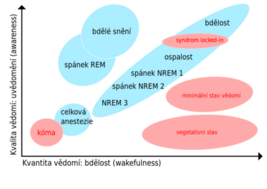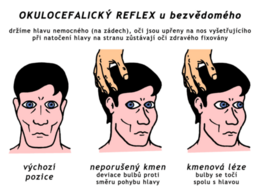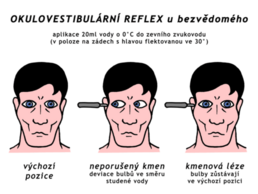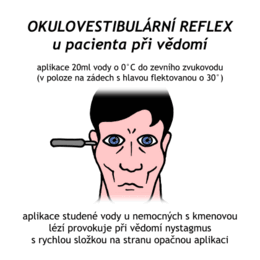Unconsciousness
From WikiLectures
Disorders of consciousness[edit | edit source]
- Qualitative (confusion, disorientation, delirium),
- Quantitative (apathy, somnolence, sopor, semicoma, subcoma, coma, deep coma and death),
- somnolence - a milder form of impaired consciousness, the patient must be aroused by irritation, address, touch and then is fully oriented
- sopor - a more severe form of impaired consciousness, where the patient can be brought back to short-term consciousness only by severe painful irritation,
- resuscitation - the affected person is awake but is not aware of his / her activity (for example during hypoglycaemia).
- in a patient with impaired consciousness, we are actively looking for symptoms that may lead to an urgent surgical indication,
- the state of consciousness depends on the activity of ARAS (activating reticular ascending system) - it is stored in the rostral region of the pontoon, mesencephalus and thalamus,
- Consciousness has two components - content (quality) and (quantity) degree of vigilance.
Glasgow Coma Scale – GCS[edit | edit source]
- assessment of the level of consciousness regardless of the focal neurological finding,
- it is the sum of three values for - eye opening, motoric response and verbal response,
- the minimum is GCS 3 and the maximum is 15,
- there are a total of 4 points for opening the eyes (spontaneously, to address, for pain, nothing at all),
- there are 5 points for a verbal answer,
- there are 6 points for motor response (there is important decerebration - 2b, and decortication - 3b),
- if GCS <7 we talk about coma state,
- for GCS <8 intubation is appropriate,
- if GCS <13 we have to hospitalize the patient.
Other investigations in the unconscious[edit | edit source]
- lateralization,
- we are actively looking for symptoms of asymmetry - motor skills and pupils,
- bulb movements,
- sometimes we find stray movements of bulbs, testify to preserved oculomotor skills, are a good symptom,
- pupils,
- we notice the size (we record in mm), symmetry and reaction to exposure,
- anisocoria - testifies to the oppression of n. III on the edge of the tentoria,
- symmetric miosis - if there is a decortication reaction to pain, it indicates central herniation,
- symmetric mydriasis without photoreaction - very advanced deterioration of strain functions,
- we notice the size (we record in mm), symmetry and reaction to exposure,
- oculocephalic reflexes - in the state of unconsciousness we turn the patient's head (only when the spine is not injured!) and if the trunk is intact, the unconscious patient fixes the sight in one position,
- motor examination,
- we monitor the tone of the muscles, the reflexes, the symmetry of spontaneous movements during pain,
- breathing disorders(abnormalities).
Differential diagnostics[edit | edit source]
The list of causes is for orientation !
Simply (for use beside the patient) for a dozen causes of unconsciousness
neurogenic causes
- apoplexy, KCP, meningitis, encephalitis, brain tumors, epilepsy, SAK, thrombosis, embolism, air embolism, brain abscess, narcolepsy, brain commotion, contusion.
- clinical picture - signs of lateralization, areaactive pupils, anisocoria, are not present or asymmetric extraocular motor or other brainstem reflexes, we notice an absent gaze, strabismus, there are obvious signs of trauma.
- primarily psychogenic causes - psychogenic stupor - hysteria, deep hypnosis,
- there are absent abnormal neurological signs, normal pupils, lack of oculocephalic reflexes, normal oculovestibular reflexes, tightly closed eyes, the patient's hands do not fall on the face, if we drop them directly above him, a history of psychiatric illness.
- exogenous causes
- poisoning,,
- ethanol, hypnotics, addictive substances, general anesthetics, fungi (for example, amanita phalloides), carbon monoxide,…
- infection,
- meningitis, tetanus, botulism, scabies, rabies,…
- physical cause,
- hypothermia, hyperthermia, electric shock, burns, colds, drowning
- endogenous causes (metabolic)
- toxic,
- liver, uremia, pseudouremia, eclampsia,
- endocrine,
- diabetic coma (hyperglycemia),
- nausea, vomiting, dehydration, acetone in the breath, polyuria, rapid deep breathing, tachycardia,
- hypoglycemia,
- sweating, tremor, hunger, weakness, headache, shallow breathing, tachycardia, increased blood pressure, damp skin, sudden onset,
- hyperosmolar - thirst, weakness, dehydration, hallucinations, delirium, convulsions,
- lactacidemic coma, thyrotoxic crisis, hypothyroid coma, pituitary coma, adrenal insufficiency coma (Addison), hypocalcemic coma (tetanus), hypercalcemic coma.
- diabetic coma (hyperglycemia),
- cardiovascular causes
- coronary heart disease - cardiogenic shock.
- arrhythmia - atrial fibrillation with the risk of thromboembolism.
- AV blockade III. degree - Morgagni-Adams-Stokes syndrome.
- ventricular tachycardia.
- sick-sinus syndrome,
- circulatory syncope - orthostatic collapse, carotid sinus syndrome (vagovagal reflex), aortic arch syndrome, subclavial steal syndrome, vertebrobasilar insufficiency, dissecting aortic aneurysm, sinus tumor and valve thrombus.
- congenital heart defects,
- acute cardiac tamponade,
- hemorrhagic shock,
- hypertensive crisis.
- respiratory disorders
- hypoxia, anoxia, hypocapnia (from hyperventilation), hypercapnia, lung diseases.
- water and electrolyte imbalances,
- dysequilibration system (hyponatremia - water poisoning), severe dehydration - increase in blood viscosity, decrease in blood pressure, hypochloraemia, hypokalemia, hyperkalemia.
Care of the unconscious person[edit | edit source]
- place the affected person in a stabilized position,
- it is recommended to turn the affected person to the other side after every 30 minutes in a stabilized position,
- we regularly evaluate blood circulation and respiration; if necessary, resuscitation is started immediately
Links[edit | edit source]
Related articles[edit | edit source]
External links[edit | edit source]
References[edit | edit source]
- BENEŠ, Jiří. Studijní materiály [online]. ©2007. [cit. 2009]. <http://jirben2.chytrak.cz/materialy/orl_jb.doc>.
- BYDŽOVSKÝ, Jan. První pomoc. 2. edition. Praha : GRADA, 2001. pp. 18-19. ISBN 80-247-0099-9.
Kategorie:Chirurgie Kategorie:Anesteziologie Kategorie:Neurologie




